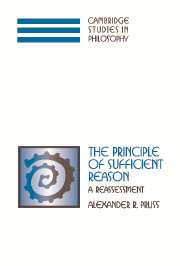Book contents
- Frontmatter
- Contents
- Acknowledgments
- Part I The Principle of Sufficient Reason and the Causal Principle
- Part II Objections to the PSR
- Part III Justifications of the PSR
- 11 Self-Evidence
- 12 Three Thomistic Arguments
- 13 Modal Arguments
- 14 Is the Universe Reasonable?
- 15 Explanation of Negative States of Affairs
- 16 The Puzzle of the Everyday Applicability of the PSR
- 17 Inference to the Best or Only Explanation
- 18 Inductive Skepticism
- 19 The Nature of Possibility
- 20 Conclusions
- Bibliography
- Index
17 - Inference to the Best or Only Explanation
Published online by Cambridge University Press: 27 July 2009
- Frontmatter
- Contents
- Acknowledgments
- Part I The Principle of Sufficient Reason and the Causal Principle
- Part II Objections to the PSR
- Part III Justifications of the PSR
- 11 Self-Evidence
- 12 Three Thomistic Arguments
- 13 Modal Arguments
- 14 Is the Universe Reasonable?
- 15 Explanation of Negative States of Affairs
- 16 The Puzzle of the Everyday Applicability of the PSR
- 17 Inference to the Best or Only Explanation
- 18 Inductive Skepticism
- 19 The Nature of Possibility
- 20 Conclusions
- Bibliography
- Index
Summary
CAN INFERENCE TO BEST OR ONLY EXPLANATION BE RATIONAL WITHOUT THE PSR?
A number of scientific inference schemes have the structure: We have a phenomenon Φ – ideally, one that comprises a cluster of different phenomena – and a number of explanatory hypotheses H1, …, Hn, that is, hypotheses each of which would explain Φ were the hypothesis in question true. Of these, Hi is the best or most plausible or most probable. Hence, probably Hi holds. The question of how we tell which of the hypotheses should be chosen – what “best” or “most plausible” means – is of course the area where much controversy lies, but I will avoid this question. Schemes having this general form I will label inference to best explanation (IBE), though some Bayesian schemes not always contained under that label will qualify, as long as the hypotheses among which one is choosing on Bayesian grounds are explanatory.
I will be interested in this inference scheme to the extent that it is considered to be truth-directed in a realist sense. The nonrealist about inference to best explanation will thus not be interested in what follows. Indeed, some may find the following considerations moving them to this nonrealist stance.
IBE then holds that given a number of putative explanations, the one that is in some sense best is likely true. But what if in fact the phenomenon has no explanation at all? What if the phenomenon is just a brute fact?
- Type
- Chapter
- Information
- The Principle of Sufficient ReasonA Reassessment, pp. 280 - 294Publisher: Cambridge University PressPrint publication year: 2006



